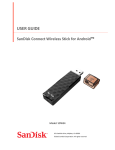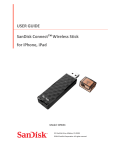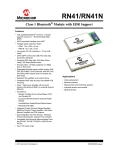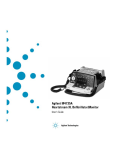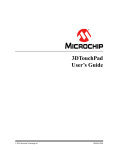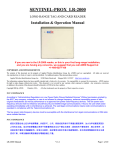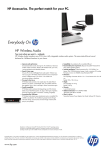Download Datasheet
Transcript
MRF24WN0MA/MB 2.4 GHz IEEE 802.11b/g/n Wireless Module Features • IEEE 802.11b/g/n Compliant Transceiver • 2.4 GHz IEEE 802.11n Single Stream 1x1 • SPI Interface to Host Controller (4-wire including interrupt) • Works with Microchip's MPLAB® Harmony Integrated Software Framework • Fully Integrated Wireless Module with Voltage Regulation, Crystal, RF Matching Circuitry, Power Amplifier (PA), Low Noise Amplifier (LNA), and PCB Trace Antenna • Ultra-Small W.FL Connector for External Antennas (MRF24WN0MB) • Compact Surface Mount Module: 0.700" x 1.050" x 0.085“ (17.8 mm x 26.7 mm x 2.2 mm) • Castellated Surface Mount Pads for easy and reliable PCB mounting • Environmentally Friendly, RoHS Compliant Compliance Operational • Single Operating Voltage: 3.15V to 3.45V (3.3V typical) • Temperature Range: -40°C to +85°C Industrial • Low-Current Consumption: - RX mode: 64 mA (typical) - TX mode: 246 mA at 18 dBm (typical) • Power Saving Mode: - Hibernate: 10 µA (typical) RF/Analog • Frequency: 2.412 to 2.472 GHz • Channels: 1-13 • Modulation: DSSS, CCK, BPSK, QPSK, 16QAM, 64QAM • Sensitivity: -94 dBm • Modular Certified for the United States (FCC) and Canada (IC) • European R&TTE Directive Assessed Radio Module • Australia, New Zealand, Korea, Taiwan, and Japan Applications • • • • • • Utility and Smart Energy Consumer Electronics Industrial Controls Remote Device Management Retail Medical, Fitness, and Health Care Antenna • Integral PCB Trace Antenna (MRF24WN0MA) • External Antenna (MRF24WN0MB) 2015 Microchip Technology Inc. Advance Information DS50002410A-page 1 MRF24WN0MA/MB Table of Contents 1.0 Device Overview .......................................................................................................................................................................... 3 2.0 Circuit Description .......................................................................................................................................................................11 3.0 Application Information............................................................................................................................................................... 15 4.0 Regulatory Approval ................................................................................................................................................................... 21 5.0 Electrical Characteristics ............................................................................................................................................................ 27 Appendix A: Revision History............................................................................................................................................................... 29 The Microchip Web Site ....................................................................................................................................................................... 31 Customer Change Notification Service ................................................................................................................................................ 31 Customer Support ................................................................................................................................................................................ 31 Product Identification System............................................................................................................................................................... 33 TO OUR VALUED CUSTOMERS It is our intention to provide our valued customers with the best documentation possible to ensure successful use of your Microchip products. To this end, we will continue to improve our publications to better suit your needs. Our publications will be refined and enhanced as new volumes and updates are introduced. If you have any questions or comments regarding this publication, please contact the Marketing Communications Department via E-mail at [email protected]. We welcome your feedback. Most Current Data Sheet To obtain the most up-to-date version of this data sheet, please register at our Worldwide Web site at: http://www.microchip.com You can determine the version of a data sheet by examining its literature number found on the bottom outside corner of any page. The last character of the literature number is the version number, (e.g., DS30000000A is version A of document DS30000000). Errata An errata sheet, describing minor operational differences from the data sheet and recommended workarounds, may exist for current devices. As device/documentation issues become known to us, we will publish an errata sheet. The errata will specify the revision of silicon and revision of document to which it applies. To determine if an errata sheet exists for a particular device, please check with one of the following: • Microchip’s Worldwide Web site; http://www.microchip.com • Your local Microchip sales office (see last page) When contacting a sales office, please specify which device, revision of silicon and data sheet (include literature number) you are using. Customer Notification System Register on our web site at www.microchip.com to receive the most current information on all of our products. DS50002410A-page 2 Advance Information 2015 Microchip Technology Inc. MRF24WN0MA/MB 1.0 DEVICE OVERVIEW The MRF24WN0MA and MRF24WN0MB are lowpower, 2.4 GHz, IEEE 802.11n compliant, surface mount modules containing all associated RF components: crystal oscillator, bypass and bias passives with integrated MAC, baseband, RF and power amplifier, and built-in hardware support for encryption. Refer to Figure 1-1. The integrated module design frees the designer from RF and antenna design tasks and regulatory compliance testing, ultimately providing faster time to market. The MRF24WN0MA/MB modules are designed to be used with Microchip's MPLAB® Harmony Integrated Software Framework. The integrated framework implements the Application Programming Interface (API) that is used for command and control, management and data packet traffic. The MPLAB Harmony basic framework is available via a free download from the Microchip web site at http://www.microchip.com/harmony. For more information on the basic framework and available release versions, refer to “MPLAB® Harmony Release Notes and Contents” found under the Documentation tab. FIGURE 1-1: The MRF24WN0MA module is approved for use with the integrated PCB trace antenna. The MRF24WN0MB module is approved for use with specific external antenna types that are certified with the module. An ultra-small coaxial connector (W.FL) is provided on the module for connection to the external antenna. Refer to Section 3.3, "External Antenna Types" for a listing of approved antenna types. The MRF24WN0MA/MB modules received the regulatory approvals for modular devices in the United States (FCC) and Canada (IC). Modular approval removes the need for expensive RF and antenna design, and enables the end user to place the MRF24WN0MA/MB modules inside a finished product without requiring a regulatory testing for an intentional radiator (RF transmitter). The MRF24WN0MA/MB module is an R&TTE Directive assessed radio module for operation in Europe. The module tests can be applied toward final product certification and Declaration of Conformity (DoC). Table 1-1 lists the MFR24WN0 module’s family types. TABLE 1-1: MRF24WN0 FAMILY TYPES Device Antenna MRF24WN0MA Integral MRF24WN0MB External MRF24WN0MA/MB BLOCK DIAGRAM MRF24WN0MA/MB 2.4 GHz IEEE 802.11 b/g/n Module PCB Trace Antenna (MRF24WN0MA) Hibernate Interrupt Matching Circuitry External Antenna Connector (MRF24WN0MB) 2015 Microchip Technology Inc. Wi-Fi SoC SPI Power Flash Advance Information DS50002410A-page 3 MRF24WN0MA/MB 1.1 Interface Description Figure 1-2 shows the MRF24WN0MA/MB pin diagram. Table 1-2 describes the MRF24WN0MA/MB pins. FIGURE 1-2: MRF24WN0MA/MB PIN DIAGRAM 1 2 3 4 5 6 7 8 9 10 11 12 13 14 37 36 35 34 33 32 31 30 29 28 27 26 25 24 GND GND VDD GND NC NC NC NC NC NC GND NC NC GND VDD GND TEST TEST HIBERNATE SPI_INT MODE0 SPI_MOSI SPI_CS/MODE1 15 16 17 18 19 20 21 22 23 GND TEST GND VDD NC NC NC NC NC NC NC NC SPI_CLK SPI_MISO DS50002410A-page 4 Advance Information 2015 Microchip Technology Inc. MRF24WN0MA/MB TABLE 1-2: PIN DESCRIPTIONS Pin Name Description(1) Type 1 GND Power — 2 TEST Test Do not connect 3 GND Power — 4 VDD Power — 5 NC Reserved Do not connect 6 NC Reserved Do not connect 7 NC Reserved Do not connect 8 NC Reserved Do not connect 9 NC Reserved Do not connect 10 NC Reserved Do not connect 11 NC Reserved Do not connect 12 NC Reserved Do not connect 13 SPI_CLK DI SPI clock input 14 SPI_MISO DO SPI data output; pull-down to GND with 10 kilo-ohm resistor 15 VDD Power — 16 GND Power — 17 TEST Test Do not connect 18 TEST Test Do not connect 19 HIBERNATE DI Lowest Power State (active-low) 20 SPI_INT DO SPI interrupt output (active-low) 21 MODE0 DI Mode select 0; Connect to GND(2) 22 SPI_MOSI DI SPI data input 23 SPI_CS/MODE1 DI SPI Chip Select/Mode select 1; Connect to VDD via 10 kilo-ohm pull-up resistor(2)(3) 24 GND Power — 25 NC Reserved Do not connect 26 NC Reserved Do not connect 27 GND Power — 28 NC Reserved Do not connect 29 NC Reserved Do not connect 30 NC Reserved Do not connect 31 NC Reserved Do not connect 32 NC Reserved Do not connect 33 NC Reserved Do not connect 34 GND Power — 35 VDD Power — 36 GND Power — 37 GND Power — Legend: A = Analog, D = Digital, I = Input, O = Output Note 1: For NC = No Connect pins, do not make any connection. The module is configured with internal pull-up and pull-down resistors. 2: Refer to Section 2.2, "MODE0 and MODE1 Pins" 3: Refer to Section 2.3, "SPI Port Pins" 2015 Microchip Technology Inc. Advance Information DS50002410A-page 5 MRF24WN0MA/MB 1.2 Mounting Details Figure 1-3, Figure 1-4 and Figure 1-5 show the physical dimensions and the mounting details of the module. Figure 1-6 and Figure 1-7 show the recommended host PCB footprint and layout. MRF24WN0MA/MB MODULE PHYSICAL DIMENSIONS (TOP AND SIDE VIEW) FIGURE 1-3: 'LPHQVLRQVDUHLQLQFKHV 7ROHUDQFHV 3&%RXWOLQH 3&%WKLFNQHVV DS50002410A-page 6 Advance Information 2015 Microchip Technology Inc. MRF24WN0MA/MB MRF24WN0MA/MB MODULE PHYSICAL DIMENSIONS (BOTTOM VIEW) FIGURE 1-4: 'LPHQVLRQVDUHLQLQFKHV 2015 Microchip Technology Inc. Advance Information DS50002410A-page 7 MRF24WN0MA/MB FIGURE 1-5: MRF24WN0MA/MB MODULE MOUNTING DETAILS (Top View) 0.255 1.25 1.25 0.795 Edge of Host PCB Ground Plane Keep area around antenna (approximately 1.25 inches) clear of metallic structures for best performance. Dimensions are in inches DS50002410A-page 8 Advance Information 2015 Microchip Technology Inc. MRF24WN0MA/MB FIGURE 1-6: MRF24WN0MA/MB RECOMMENDED HOST PCB FOOTPRINT .HHSRXWDUHD +RVW3&% *URXQG3ODQH (GJH 6KLHOG3DGV; GLDPHWHU 2015 Microchip Technology Inc. Advance Information 'RQRWORFDWH+RVW 3&%WRSOD\HUFRSSHU XQGHU6KLHOG3DGV DS50002410A-page 9 MRF24WN0MA/MB FIGURE 1-7: MRF24WN0MA/MB HOST PCB EXAMPLE LAYOUT Best Okay Okay 1.3 No Copper in these Areas Okay Soldering Recommendations The MRF24WN0MA/MB wireless module was assembled using the IPC/JEDEC J-STD-020 Standard leadfree reflow profile. The MRF24WN0MA/MB module can be soldered to the host PCB using standard leaded and lead-free solder reflow profiles. To avoid damaging the module, adhere to the following recommendations: • Solder reflow recommendations are provided in the Microchip Application Note, AN233 "Solder Reflow Recommendation" (DS00233) • Do not exceed a peak temperature (TP) of 250°C • Refer to the solder paste data sheet for specific reflow profile recommendations from the vendor • Use no-clean flux solder paste • Do not wash as moisture can be trapped under the shield • Use only one flow. If the PCB requires multiple flows, apply the module on the final flow. DS50002410A-page 10 Advance Information 2015 Microchip Technology Inc. MRF24WN0MA/MB 2.0 CIRCUIT DESCRIPTION 2.2 2.1 Overview The MODE pins must be tied to the voltage levels for normal operation of the module. Refer to Table 2-1. The MRF24WN0MA/MB module interfaces to the PIC32 MCU via a 4-wire SPI port, Interrupt and Hibernate pins as illustrated in Figure 2-1. The MRF24WN0MA/MB modules are designed to work with Microchip's MPLAB® Harmony Integrated Software Framework. The integrated framework implements the Application Programming Interface (API) that is used for command and control, management and data packet traffic. The MPLAB Harmony basic framework is available via a free download from the Microchip web site at http://www.microchip.com/harmony. For more information on the basic framework and available release versions, refer to the “MPLAB Harmony Release Notes and Contents” found under the Documentation tab. If you are new to the MPLAB Harmony framework, visit http://www.microchip.com/harmony and go to the Training > Getting Started tab. MODE0 and MODE1 Pins TABLE 2-1: MODE PIN OPERATION Pin Condition MODE0 Connect to GND SPI_CS/MODE1 Connect to VDD via 10 k pull-up resistor The MODE pins are sampled at power on and wakeup. Refer to Section 2.6, "Hibernate". In the case of SPI_CS/MODE1 pin, pull-up using a 10 k resistor and the host MCU allows an active-high signal during power on and wake-up to ensure that the module startup in normal operation. Once the module is operational, the pin becomes the SPI Port Chip Select pin (active-low). The MPLAB Harmony Help document is available for download from the MPLAB Harmony framework directory: c:\microchip\harmony\<version>\doc. The PIC32 input/output ports (SPI, Interrupt and Hibernate) are configured in the MPLAB Harmony framework configuration files as described in the MPLAB Harmony Help document. FIGURE 2-1: HARMONY TO MRF24WN0MA/MB BLOCK DIAGRAM PIC32 Application(s) TCP/IP Stack Wi-Fi Driver Power Ground 2015 Microchip Technology Inc. Interrupt Hibernate SPI PLIB MRF24WN0MA/MB Advance Information DS50002410A-page 11 MRF24WN0MA/MB 2.3 SPI Port Pins The MRF24WN0MA/MB module interfaces to the PIC32 MCU via a 4-wire SPI port. Refer to Figure 2-2 and Table 2-2 for the necessary signaling conditions. In the case of the SPI_CS/MODE1 pin, pull-up using a 10 k resistor and the host MCU allows an active-high signal during power on and wake-up to ensure that the module start-up in normal operation. Once the module is operational, the pin becomes the SPI Port Chip Select pin (active-low). FIGURE 2-2: SPI SLAVE INTERFACE TIMING fPP VIH tWL Clock tWH tTHL VIL tTLH tIH tISU VIH MOSI VIL VOH MISO VOL tO_DLY(max) TABLE 2-2: tO_DLY(min) SPI SLAVE TIMING CONSTRAINTS Parameter Description Min. Max. Unit fPP Clock Frequency 0 48 MHz tWL Clock Low Time 8.3 — ns tWH Clock High Time 8.3 — ns tTLH Clock Rise Time — 2 ns tTHL Clock Fall Time — 2 ns tISU Input Setup Time 5 — ns tIH Input Hold Time 5 — ns Output Delay 0 5 ns tO_DLY DS50002410A-page 12 Advance Information 2015 Microchip Technology Inc. MRF24WN0MA/MB 2.4 Interrupt Pin The SPI_INT line works in conjunction with the SPI port. It is an active-low output signal to the host MCU to signal an interrupt event. 2.5 VDD and GND Pin The MRF24WN0MA/MB wireless module contains an integrated power management unit that generates all necessary voltages required by the internal circuitry. The module is powered from a single voltage source. Table 2-3 lists the recommended bypass capacitors. The capacitors must be closely placed to the module. TABLE 2-3: RECOMMENDED BYPASS CAPACITORS Pin Symbol Bypass Capacitors 4 VDD 0.1 µF and 2.2 µF 15 VDD 0.1 µF and 2.2 µF 35 VDD 0.1 µF and 2.2 µF 2.6 Hibernate The module enters the lowest power mode when the HIBERNATE pin is asserted low. No state information is preserved. The MPLAB Harmony framework can save state information in the host MCU that can be restored after wake-up (HIBERNATE pin is asserted high). The module can wake-up when HIBERNATE pin is asserted high. The module must be initialized and any state information saved prior to Hibernate state is restored. This process approximately takes 40 ms. 2015 Microchip Technology Inc. Advance Information DS50002410A-page 13 MRF24WN0MA/MB NOTES: DS50002410A-page 14 Advance Information 2015 Microchip Technology Inc. MRF24WN0MA/MB 3.0 APPLICATION INFORMATION This section provides information on the Application Schematic, Integral PCB Trace Antenna, and Antenna Types. 3.1 Application Schematic Figure 3-1 shows the schematic for the MRF24WN0MA module. FIGURE 3-1: APPLICATION SCHEMATIC 8 05):10$ 9 & μ) 9'' *1' 7(67 7(67 +,%(51$7( 63,B,17 02'( 63,B026, 63,B&602'( & μ) *1' 1& 7(67 *1' 9'' 1& 1& 1& 1& 1& 1& 1& 1& 1& 1& 1& 1& 1& 1& 1& 1& 63,B&/. 63,B0,62 5 N: 9 *1' *1' 9'' *1' 1& 1& 1& 1& 1& 1& *1' 1& 1& *1' 9 1& 1& 1& 1& 1& 1& & μ) & μ) 1& 1& 1& 1& +RVW0&8 ,QWHUIDFH & μ) & μ) 9 5 N: 9 5 N: 2015 Microchip Technology Inc. Advance Information DS50002410A-page 15 MRF24WN0MA/MB 3.2 Integral PCB Trace Antenna For the MRF24WN0MA, the PCB antenna is fabricated on the top copper layer and covered in solder mask. The layers below the antenna do not have copper trace. It is recommended that the module is mounted on the edge of the host PCB. It is permitted for PCB material to be below the antenna structure of the module as long as no copper traces or planes are on the host PCB in that area. For best performance, place the module on the host PCB according to the details shown in Figure 1-6. The antenna patterns plotted in Figure 3-2 through Figure 3-5 are the simulated results of the PCB antenna. FIGURE 3-2: DS50002410A-page 16 Figure 3-2 illustrates the simulation drawing. The twodimensional (2D) radiation pattern is illustrated in Figure 3-3, whereas Figure 3-4 and Figure 3-5 shows the three-dimensional (3D) radiation patterns. The calculated average of the radiated field is shown in Figure 3-3. The radiation pattern for the XZ plane is shown in red, whereas the YZ plane is shown in violet. The most powerful radiation occurs in the XZ plane as represented by the red pattern. Figure 3-4 shows the relative position of the 3D radiation “donut” with reference to the module orientation. This is a very useful guide for placement of the module to obtain the maximum range. Figure 3-5 shows the 3D radiation pattern with the colored distribution of the radiation magnitude. The values range from -9 dB to +0.3 dB. This is very useful in interpreting the 2D radiation pattern. PCB ANTENNA SIMULATION DRAWING Advance Information 2015 Microchip Technology Inc. MRF24WN0MA/MB FIGURE 3-3: SIMULATED TWO-DIMENSIONAL RADIATION PATTERN Name Theta Angle Mag. Curve Information Average m1 -60.0000 -60.0000 0.6323 0.0097 m2 -20.0000 -20.0000 0.3962 m3 30.0000 30.0000 -0.1038 dB (Gain Total) Setup 1: Last Adaptive Freq. = “2.44 GHz” Phi = “0 deg” m4 100.0000 100.0000 -0.9490 170.0000 170.0000 -0.1414 dB (Gain Total) Setup 2: Last Adaptive Freq. = “2.44 GHz” Phi = “0 deg” -3.2020 m5 Radiation Pattern 1 Two-dimensional (2D) pattern, including the average on main radiation planes (Phi = 0 and 90 degrees). 2015 Microchip Technology Inc. Advance Information DS50002410A-page 17 MRF24WN0MA/MB FIGURE 3-4: SIMULATED THREE-DIMENSIONAL RADIATION PATTERN Radiation pattern against the module dimensions DS50002410A-page 18 Advance Information 2015 Microchip Technology Inc. 2015 Microchip Technology Inc. FIGURE 3-5: SIMULATED THREE-DIMENSIONAL RADIATION PATTERN DS50002410A-page 19 MRF24WN0MA/MB Advance Information Three-dimensional (3D) pattern and magnitude distribution MRF24WN0MA/MB 3.3 External Antenna Types The MRF24WN0MB module has an ultra-small coaxial connector (W.FL) for connection to the external antenna. The choice of antenna is limited to the antenna types in which the module is tested and approved. For a list of tested and approved antenna types that may be used with the module, refer to the respective country in Section 4.0, Regulatory Approval. Table 3-1 lists the approved antennas types. TABLE 3-1: TESTED EXTERNAL ANTENNA TYPES Type Gain PCB Trace 1 dBi Dipole 2 dBi PIFA -3 dBi DS50002410A-page 20 Advance Information 2015 Microchip Technology Inc. MRF24WN0MA/MB 4.0 REGULATORY APPROVAL This section outlines the regulatory information for the MRF24WN0MA/MB module for the following countries: • • • • • • • • • United States Canada Europe Australia New Zealand Japan Korea Taiwan Other Regulatory Jurisdictions 4.1 4.1.1 LABELING AND USER INFORMATION REQUIREMENTS The MRF24WN0MA/MB module has been labeled with its own FCC ID number, and if the FCC ID is not visible when the module is installed inside another device, then the outside of the finished product into which the module is installed must also display a label referring to the enclosed module. This exterior label can use wording as follows: MRF24WN0MA/MB: Contains Transmitter Module FCC ID: W7O24WN0 or Contains FCC ID: W7O24WN0 United States The MRF24WN0MA/MB module has received Federal Communications Commission (FCC) CFR47 Telecommunications, Part 15 Subpart C “Intentional Radiators” modular approval in accordance with Part 15.212 Modular Transmitter approval. Modular approval allows the end user to integrate the MRF24WN0MA/MB module into a finished product without obtaining subsequent and separate FCC approvals for intentional radiation, provided no changes or modifications are made to the module circuitry. Changes or modifications could void the user’s authority to operate the equipment. The end user must comply with all of the instructions provided by the Grantee, which indicate installation and/or operating conditions necessary for compliance. The finished product is required to comply with all applicable FCC equipment authorizations regulations, requirements and equipment functions not associated with the transmitter module portion. For example, compliance must be demonstrated to regulations for other transmitter components within the host product; to requirements for unintentional radiators (Part 15 Subpart B “Unintentional Radiators”), such as digital devices, computer peripherals, radio receivers, etc.; and to additional authorization requirements for the non-transmitter functions on the transmitter module (i.e., Verification, or Declaration of Conformity) (e.g., transmitter modules may also contain digital logic functions) as appropriate. This device complies with Part 15 of the FCC Rules. Operation is subject to the following two conditions: (1) this device may not cause harmful interference, and (2) this device must accept any interference received, including interference that may cause undesired operation A user’s manual for the product should include the following statement: This equipment has been tested and found to comply with the limits for a Class B digital device, pursuant to part 15 of the FCC Rules. These limits are designed to provide reasonable protection against harmful interference in a residential installation. This equipment generates, uses and can radiate radio frequency energy, and if not installed and used in accordance with the instructions, may cause harmful interference to radio communications. However, there is no guarantee that interference will not occur in a particular installation. If this equipment does cause harmful interference to radio or television reception, which can be determined by turning the equipment off and on, the user is encouraged to try to correct the interference by one or more of the following measures: • Reorient or relocate the receiving antenna. • Increase the separation between the equipment and receiver. • Connect the equipment into an outlet on a circuit different from that to which the receiver is connected. • Consult the dealer or an experienced radio/TV technician for help. Additional information on labeling and user information requirements for Part 15 devices can be found in KDB Publication 784748 available at the FCC Office of Engineering and Technology (OET) Laboratory Division Knowledge Database (KDB) http://apps.fcc.gov/oetcf/kdb/index.cfm. 2015 Microchip Technology Inc. Advance Information DS50002410A-page 21 MRF24WN0MA/MB 4.1.2 RF EXPOSURE All transmitters regulated by FCC must comply with RF exposure requirements. KDB 447498 General RF Exposure Guidance provides guidance in determining whether proposed or existing transmitting facilities, operations or devices comply with limits for human exposure to Radio Frequency (RF) fields adopted by the Federal Communications Commission (FCC). This module is approved for installation into mobile and/or portable host platforms and must not be colocated or operating in conjunction with any other antenna or transmitter except in accordance with FCC multitransmitter guidelines. End users must be provided with transmitter operating conditions for satisfying RF Exposure compliance. 4.1.3 APPROVED EXTERNAL ANTENNA TYPES To maintain modular approval in the United States, only the antenna types that have been tested shall be used. It is permissible to use different antenna manufacturers provided the same antenna type that has similar inband and out-of-band radiation patterns and antenna gain (equal to or less than) is used. Modular approval testing of the MRF24WN0MA/MB module was performed with the antenna types listed in Table 3-1. 4.1.4 HELPFUL WEB SITES Federal Communications Commission (FCC): http://www.fcc.gov FCC Office of Engineering and Technology (OET) Laboratory Division Knowledge Database (KDB): http://apps.fcc.gov/oetcf/kdb/index.cfm 4.2 Canada The MRF24WN0MA/MB module has been certified for use in Canada under Industry Canada (IC) Radio Standards Specification (RSS) RSS-210 and RSSGen. Modular approval permits the installation of a module in a host device without the need to recertify the device. 4.2.1 LABELING AND USER INFORMATION REQUIREMENTS Labeling Requirements for the Host Device (from Section 3.2.1, RSS-Gen, Issue 3, December 2010): The host device shall be properly labeled to identify the module within the host device. The Industry Canada certification label of a module shall be clearly visible at all times when installed in the host device, otherwise the host device must be labeled to display the Industry Canada certification number of the module, preceded by the words “Contains transmitter module”, or the word “Contains”, or similar wording expressing the same meaning, as follows: Contains transmitter module IC: 7693A-24WN0 User Manual Notice for License-Exempt Radio Apparatus (from Section 7.1.3 RSS-Gen, Issue 3, December 2010): User manuals for license-exempt radio apparatus shall contain the following or equivalent notice in a conspicuous location in the user manual or alternatively on the device or both: This device complies with Industry Canada licenseexempt RSS standard(s). Operation is subject to the following two conditions: (1) this device may not cause interference, and (2) this device must accept any interference, including interference that may cause undesired operation of the device. Le présent appareil est conforme aux CNR d'Industrie Canada applicables aux appareils radio exempts de licence. L'exploitation est autorisée aux deux conditions suivantes: (1) l'appareil ne doit pas produire de brouillage, et (2) l'utilisateur de l'appareil doit accepter tout brouillage radioélectrique subi, même si le brouillage est susceptible d'en compromettre le fonctionnement. Transmitter Antenna (from Section 7.1.2 RSS-Gen, Issue 3, December 2010): User manuals for transmitters shall display the following notice in a conspicuous location: Under Industry Canada regulations, this radio transmitter may only operate using an antenna of a type and maximum (or lesser) gain approved for the transmitter by Industry Canada. To reduce potential radio interference to other users, the antenna type and its gain should be so chosen that the equivalent isotropically radiated power (e.i.r.p.) is not more than that necessary for successful communication. Conformément à la réglementation d'Industrie Canada, le présent émetteur radio peut fonctionner avec une antenne d'un type et d'un gain maximal (ou inférieur) approuvé pour l'émetteur par Industrie Canada. Dans le but de réduire les risques de brouillage radioélectrique à l'intention des autres utilisateurs, il faut choisir le type d'antenne et son gain de sorte que la puissance isotrope rayonnée équivalente (p.i.r.e.) ne dépasse pas l'intensité nécessaire à l'établissement d'une communication satisfaisante. The above notice may be affixed to the device instead of displayed in the user manual. 4.2.2 RF EXPOSURE All transmitters regulated by IC must comply with RF exposure requirements listed in RSS-102 - Radio Frequency (RF) Exposure Compliance of Radiocommunication Apparatus (All Frequency Bands). DS50002410A-page 22 Advance Information 2015 Microchip Technology Inc. MRF24WN0MA/MB This module is approved for installation into mobile and/or portable host platforms and must not be colocated or operating in conjunction with any other antenna or transmitter except in accordance with Industry Canada's multi-transmitter guidelines. End users must be provided with transmitter operating conditions for satisfying RF Exposure compliance. 4.2.3 The R&TTE Compliance Association provides guidance on modular devices in document Technical Guidance Note 01 available at http://www.rtteca.com/html/download_area.htm. Note: APPROVED EXTERNAL ANTENNA TYPES Transmitter Antenna (from Section 7.1.2 RSS-Gen, Issue 3, December 2010): The MRF24WN0MA/MB module can only be sold or operated with antennas with which it was approved. Transmitter may be approved with multiple antenna types. An antenna type comprises antennas having similar in-band and out-of-band radiation patterns. Testing shall be performed using the highest gain antenna of each combination of transmitter and antenna type for which approval is being sought, with the transmitter output power set at the maximum level. Any antenna of the same type having equal or lesser gain as an antenna that had been successfully tested with the transmitter, will also be considered approved with the transmitter, and may be used and marketed with the transmitter. When a measurement at the antenna connector is used to determine RF output power, the effective gain of the device's antenna shall be stated, based on measurement or on data from the antenna manufacturer. For transmitters of output power greater than 10 milliwatts, the total antenna gain shall be added to the measured RF output power to demonstrate compliance to the specified radiated power limits. Modular approval testing of the MRF24WN0MA/MB module was performed with the antenna types listed in Table 3-1. 4.2.4 HELPFUL WEB SITES Europe The MRF24WN0MA/MB module is an R&TTE Directive assessed radio module that is CE marked and has been manufactured and tested with the intention of being integrated into a final product. The MRF24WN0MA/MB module has been tested to R&TTE Directive 1999/5/EC Essential Requirements for Health and Safety (Article (3.1(a)), Electromagnetic Compatibility (EMC) (Article 3.1(b)), and Radio (Article 3.2) and are summarized in Table 3-1: European Compliance Testing. A Notified Body Opinion has also been issued. All test reports are available on the MRF24WN0MA/MB product web page at http:// www.microchip.com. 2015 Microchip Technology Inc. When integrating a radio module into a completed product the integrator becomes the manufacturer of the final product and is therefore responsible for demonstrating compliance of the final product with the essential requirements of the R&TTE Directive. 4.3.1 LABELING AND USER INFORMATION REQUIREMENTS The label on the final product which contains the MRF24WN0MA/MB module must follow CE marking requirements. The “R&TTE Compliance Association Technical Guidance Note 01” provides guidance on final product CE marking. 4.3.2 EXTERNAL ANTENNA REQUIREMENTS From R&TTE Compliance Association document Technical Guidance Note 01: Provided the integrator installing an assessed radio module with an integral or specific antenna and installed in conformance with the radio module manufacturer’s installation instructions requires no further evaluation under Article 3.2 of the R&TTE Directive and does not require further involvement of an R&TTE Directive Notified Body for the final product. [Section 2.2.4] The European Compliance Testing listed in Table 4-1 was performed using the antenna types listed in Table 3-1. Industry Canada: http://www.ic.gc.ca/ 4.3 To maintain conformance to the testing listed in Table 4-1, the module shall be installed in accordance with the installation instructions in this data sheet and shall not be modified. 4.3.3 HELPFUL WEB SITES A document that can be used as a starting point in understanding the use of Short Range Devices (SRD) in Europe is the European Radio Communications Committee (ERC) Recommendation 70-03 E, which can be downloaded from the European Radio Communications Office (ERO) at: http://www.ero.dk/. Additional helpful web sites are: • Radio and Telecommunications Terminal Equipment (R&TTE): http://ec.europa.eu/enterprise/rtte/index_en.htm • European Conference of Postal and Telecommunications Administrations (CEPT): http://www.cept.org/ Advance Information DS50002410A-page 23 MRF24WN0MA/MB • European Telecommunications Standards Institute (ETSI): http://www.etsi.org • European Radio Communications Office (ERO): http://www.ero.dk/ • The Radio and Telecommunications Terminal Equipment Compliance Association (R&TTE CA): http://www.rtteca.com/ TABLE 4-1: MRF24WN0MA/MB EUROPEAN COMPLIANCE TESTING Certification Standards Article Laboratory Safety EN 60950-1:2006+A11:2009+A1:2010 +A12:2011 [3.1(a)] Health EN 62479:2010 EMC EN 301 489-1 V1.9.2 (2011-09) Radio EN 300 328 V1.8.1 (2006-06) Report Number Date Pending Pending [3.1(b)] Pending (3.2) Pending EN 301 489-17 V2.2.1 (2012-09) Notified Body Opinion 4.4 Pending Australia 4.5 The Australia radio regulations do not provide a modular approval policy similar to the United States (FCC) and Canada (IC). However, MRF24WN0MA/MB module RF transmitter test reports can be used in part to demonstrate compliance in accordance with ACMA Radio communications “Short Range Devices” Standard 2004 (The Short Range Devices standard calls up the AS/NZS 4268:2008 industry standard). The MRF24WN0MA/MB module test reports can be used as part of the product certification and compliance folder. For more information on the RF transmitter test reports, contact Microchip Technology Australia sales office. To meet overall Australian final product compliance, the developer must construct a compliance folder containing all relevant compliance test reports e.g. RF, EMC, electrical safety and DoC (Declaration of Conformity) etc. It is the responsibility of the integrator to know what is required in the compliance folder for ACMA compliance. All test reports are available on the MRF24WN0MA/MB product web page at http:// www.microchip.com. For more information on Australia compliance, refer to the Australian Communications and Media Authority web site http://www.acma.gov.au/. 4.4.1 EXTERNAL ANTENNA REQUIREMENTS The compliance testing listed in Table 4-1 was performed using the antenna types listed in Table 3-1. 4.4.2 HELPFUL WEB SITES The Australian Communications and Media Authority: www.acma.gov.au/. DS50002410A-page 24 New Zealand The New Zealand radio regulations do not provide a modular approval policy similar to the United States (FCC) and Canada (IC). However, MRF24WN0MA/MB module RF transmitter test reports can be used in part to demonstrate compliance against the New Zealand “General User Radio License for Short Range Devices”. New Zealand Radio communications (Radio Standards) Notice 2010 calls up the AS / NZS 4268:2008 industry standard. The MRF24WN0MA/MB module test reports can be used as part of the product certification and compliance folder. All test reports are available on the MRF24WN0MA/MB product web page at http://www.microchip.com. For more information on the RF transmitter test reports, contact Microchip Technology sales office. Information on the New Zealand short range devices license can be found in the following web links: http://www.rsm.govt.nz/cms/licensees/types-oflicence/ general-user-licences/short-range-devices and http://www.rsm.govt.nz/cms/policy-and-planning/spectrum-policy-overview/legislation/gazette-notices/product-compliance To meet overall New Zealand final product compliance, the developer must construct a compliance folder containing all relevant compliance test reports e.g. RF, EMC, electrical safety and DoC (Declaration of Conformity) etc. It is the responsibility of the developer to know what is required in the compliance folder for New Zealand Radio communications. For more information on New Zealand compliance, refer to the web site http://www.rsm.govt.nz/. Advance Information 2015 Microchip Technology Inc. MRF24WN0MA/MB 4.5.1 EXTERNAL ANTENNA REQUIREMENTS 4.6.3 The compliance testing listed in Table 4-1 was performed using the antenna types listed in Table 3-1. 4.6 Japan The MRF24WN0MA/MB module has received type certification and is labeled with its own technical conformity mark and certification number as required to conform to the technical standards regulated by the Ministry of Internal Affairs and Communications (MIC) of Japan pursuant to the Radio Act of Japan. Integration of this module into a final product does not require additional radio certification provided installation instructions are followed and no modifications of the module are allowed. Additional testing may be required: • If the host product is subject to electrical appliance safety (for example, powered from an AC mains), the host product may require Product Safety Electrical Appliance and Material (PSE) testing. The integrator should contact their conformance laboratory to determine if this testing is required. • There is an voluntary Electromagnetic Compatibility (EMC) test for the host product administered by VCCI: http://www.vcci.jp/vcci_e/index.html 4.6.1 LABELING AND USER INFORMATION REQUIREMENTS The label on the final product which contains the MRF24WN0MA/MB module must follow Japan marking requirements. The integrator of the module should refer to the labeling requirements for Japan available at the Ministry of Internal Affairs and Communications (MIC) website. The MRF24WN0MA/MB module is labeled with its own technical conformity mark and certification number. The final product in which this module is being used must have a label referring to the type certified module inside: 4.6.2 HELPFUL WEB SITES Ministry of Internal Affairs and Communications (MIC): http://www.tele.soumu.go.jp/e/index.htm Association of Radio Industries and Businesses (ARIB): http://www.arib.or.jp/english/ 4.7 Korea The MRF24WN0MA/MB module has received certification of conformity in accordance with the Radio Waves Act. Integration of this module into a final product does not require additional radio certification provided installation instructions are followed and no modifications of the module are allowed. 4.7.1 LABELING AND USER INFORMATION REQUIREMENTS The label on the final product which contains the MRF24WN0MA/MB module must follow KC marking requirements. The integrator of the module should refer to the labeling requirements for Korea available on the Korea Communications Commission (KCC) website. The MRF24WN0MA/MB module is labeled with its own KC mark. The final product requires the KC mark and certificate number of the module: Pending MSIP-CRI-029-RN4020 4.7.2 EXTERNAL ANTENNA REQUIREMENTS The Korea compliance testing was performed using the antenna types listed in Table 3-1. 4.7.3 HELPFUL WEB SITES Korea Communications Commission (KCC): http://www.kcc.go.kr National Radio Research Agency (RRA): http://rra.go.kr Contains transmitter module with certificate number: Pending 4.6.2 EXTERNAL ANTENNA REQUIREMENTS The compliance testing was performed using the antenna types listed in Table 3-1. 2015 Microchip Technology Inc. Advance Information DS50002410A-page 25 MRF24WN0MA/MB 4.8 Taiwan The MRF24WN0MA/MB module has received compliance approval in accordance with the Telecommunications Act. Customers seeking to use the compliance approval in their product should contact Microchip Technology sales or distribution partners to obtain a Letter of Authority. Integration of this module into a final product does not require additional radio certification provided installation instructions are followed and no modifications of the module are allowed. 4.8.1 LABELING AND USER INFORMATION REQUIREMENTS The MRF24WN0MA/MB module is labeled with its own NCC mark and certificate number as below: Pending The user's manual should contain below warning (for RF device) in traditional Chinese: 注意 ! 依據 低功率電波輻射性電機管理辦法 第十二條 經型式認證合格之低功率射頻電 機,非經許可, 公司、商號或使用者均不得擅自變更頻率、 加大功率或變更原設計 之特性及功能。 第十四條 低功率射頻電機之使用不得影響飛 航安全及干擾合法通信; 經發現有干擾現象時,應立即停用,並改善 至無干擾時方得繼續使用。 前項合法通信,指依電信規定作業之無線電 信。 低功率射頻電機須忍受合法通信或工業、科 學及醫療用電波輻射性 電機設備之干擾。 DS50002410A-page 26 Advance Information 2015 Microchip Technology Inc. MRF24WN0MA/MB 5.0 ELECTRICAL CHARACTERISTICS Table 5-1, Table 5-2, Table 5-3 and Table 5-4 provide the absolute maximum ratings, recommended operating conditions, current consumption and the DC characteristics for digital IO pins of the module. TABLE 5-1: ABSOLUTE MAXIMUM RATINGS(1) Symbol Description VDD Max Rating Units -0.3 to 4.0 V Voltage on VDD with respect to GND VDI Min. Minimum digital input voltage -0.3 V VDO Max. Maximum digital input voltage VDD+0.3 V RFIN Maximum RF input (referenced to 50 ohms) +10 dBm Note 1: Stresses above those listed under "Absolute Maximum Ratings" may cause permanent damage to the device. This is a stress rating only and functional operation of the device at those or any other conditions above those indicated in the operation listings of this specification is not implied. Exposure above maximum rating conditions for extended periods may affect device reliability. TABLE 5-2: RECOMMENDED OPERATING CONDITIONS Symbol Description Min. Typ. Max. Units VDD Supply voltage 3.15 3.3 3.45 V TAMB Ambient temperature under bias -40 -- 85 °C TABLE 5-3: CURRENT CONSUMPTION(1) (NOMINAL CONDITIONS: 25°C, VDD = 3.3V) Conditions(2) Parameters Min Typ. Max IDD, Hibernate — 10 — µA — IDD, Receive — 61 — mA 11 Mbps — 64 — 54 Mbps — 62 — HT20 MCS0 — 64 — HT20 MCS7 — 72 — HT40 MCS0 — 73 — — 248 — — 246 — 6 Mbps — 242 — 11 Mbps — 211 — 54 Mbps — 263 — HT20 MCS0 — 217 — HT20 MCS7 — 222 — HT40 MCS0 — 196 — HT40 MCS7 IDD, Transmit Units HT40 MCS7 mA 1 Mbps Note 1: Current Consumption values represent Typical Peak currents. Wi-Fi applications typically operate at less than 85% TX duty cycle. TX current is dependent on such criteria as transmit power setting, transmit data rate, and bandwidth used. RX current is affected by connection distance. 2: Transmit current consumption at power output levels listed in Table 5-6. TABLE 5-4: DC CHARACTERISTICS FOR DIGITAL IO PINS Operating Conditions(1) DC CHARACTERISTICS Symbol Parameter Min. Typ. Max. Units VIH High-Level Input Voltage 1.8 — 3.6 V VIL Low-Level Input Voltage -0.3 — 0.3 V 2015 Microchip Technology Inc. Advance Information DS50002410A-page 27 MRF24WN0MA/MB TABLE 5-4: DC CHARACTERISTICS FOR DIGITAL IO PINS (CONTINUED) Operating Conditions(1) DC CHARACTERISTICS Symbol Parameter Min. Typ. Max. Units VOH High-Level Output Voltage 2.2 — 3.3 V VOL Low-Level Output Voltage 0 — 0.4 V IIH High-Level Input Current — — 0.1 µA IIL Low-Level Input Current — — 0.1 µA IOH High-Level Output — — 20 mA IOL Low-Level Output Current — — 20 mA Input Capacitance — 3 CIN Note: pF Operating temperature: 25°C; Operating voltage: VDD = 3.3V Table 5-5, Table 5-6 and Table 5-7 show the frequency characteristics of the module. TABLE 5-5: RADIO RECEIVER CHARACTERISTICS Symbol Parameter fRX RX input frequency range sRF Sensitivity CCK OFDM Conditions Min Typ(1) Max Unit — 2.412 — 2.472 GHz 1 Mbps — -95.7 — dBm 11 Mbps — -87.7 — 6 Mbps — -92.7 — 54 Mbps — -75.7 — HT20 MCS0 — -92.7 — MCS7 — -72.7 — HT40 MCS0 — -90.7 — MCS7 — -69.7 — Conditions Min Typ Max Unit — 2.412 — 2.472 GHz 1 Mbps — 20.7 — dBm 802.11g mask compliant 6 Mbps — 20.7 — 802.11g EVM compliant 54 Mbps — 18.8 — 802.11n HT20 mask compliant MCS0 — 20.7 — 802.11n HT40 mask compliant MCS0 — 18.5 — 802.11n HT20 EVM compliant MCS7 — 18.0 — 802.11n HT40 EVM compliant MCS7 — 18.4 — — — +/-1.5 — dB Note 1: Performance measured at J1. TABLE 5-6: RADIO TRANSMITTER CHARACTERISTICS Symbol fRX pOUT Parameter TX output frequency range Output power(1) 802.11b mask compliant aPC Accuracy of power control Note 1: Performance measured at J1. TABLE 5-7: SYNTHESIZER CHARACTERISTICS Symbol fC Parameter Conditions Min Typ Max Unit 2.412 — 2.472 GHz Center channel frequency Center frequency at 5 MHz spacing fREF Reference oscillator frequency +/-20 ppm — 40 — MHz fSTEP Frequency step size (at RF) — — 5 — MHz DS50002410A-page 28 Advance Information 2015 Microchip Technology Inc. MRF24WN0MA/MB APPENDIX A: REVISION HISTORY Revision A (August 2015) This is the initial released version of the document. 2015 Microchip Technology Inc. Advance Information DS50002410A-page 29 MRF24WN0MA/MB NOTES: DS50002410A-page 30 Advance Information 2015 Microchip Technology Inc. MRF24WN0MA/MB THE MICROCHIP WEB SITE CUSTOMER SUPPORT Microchip provides online support via our WWW site at www.microchip.com. This web site is used as a means to make files and information easily available to customers. Accessible by using your favorite Internet browser, the web site contains the following information: Users of Microchip products can receive assistance through several channels: • Product Support – Data sheets and errata, application notes and sample programs, design resources, user’s guides and hardware support documents, latest software releases and archived software • General Technical Support – Frequently Asked Questions (FAQ), technical support requests, online discussion groups, Microchip consultant program member listing • Business of Microchip – Product selector and ordering guides, latest Microchip press releases, listing of seminars and events, listings of Microchip sales offices, distributors and factory representatives • • • • Distributor or Representative Local Sales Office Field Application Engineer (FAE) Technical Support Customers should contact their distributor, representative or Field Application Engineer (FAE) for support. Local sales offices are also available to help customers. A listing of sales offices and locations is included in the back of this document. Technical support is available through the web site at: http://microchip.com/support. CUSTOMER CHANGE NOTIFICATION SERVICE Microchip’s customer notification service helps keep customers current on Microchip products. Subscribers will receive e-mail notification whenever there are changes, updates, revisions or errata related to a specified product family or development tool of interest. To register, access the Microchip web site at www.microchip.com. Under “Support”, click on “Customer Change Notification” and follow the registration instructions. 2015 Microchip Technology Inc. DS50002410A-page 31 MRF24WN0MA/MB NOTES: DS50002410A-page 32 2015 Microchip Technology Inc. MRF24WN0MA/MB PRODUCT IDENTIFICATION SYSTEM To order or obtain information, e.g., on pricing or delivery, refer to the factory or the listed sales office. PART NO. I RM XXX Device Temperature Range Package Device: MRF24WN0MA: MRF24WN0MB: Temperature Range: I = -40C to +85C (Industrial) Package: RM = Radio Module 2015 Microchip Technology Inc. Firmware Revision Number Examples: MRF24WN0MA-I/RM Integral Antenna External Antenna Connection Advance Information DS50002410A-page 33 MRF24WN0MA/MB NOTES: DS50002410A-page 34 Advance Information 2015 Microchip Technology Inc. Note the following details of the code protection feature on Microchip devices: • Microchip products meet the specification contained in their particular Microchip Data Sheet. • Microchip believes that its family of products is one of the most secure families of its kind on the market today, when used in the intended manner and under normal conditions. • There are dishonest and possibly illegal methods used to breach the code protection feature. All of these methods, to our knowledge, require using the Microchip products in a manner outside the operating specifications contained in Microchip’s Data Sheets. Most likely, the person doing so is engaged in theft of intellectual property. • Microchip is willing to work with the customer who is concerned about the integrity of their code. • Neither Microchip nor any other semiconductor manufacturer can guarantee the security of their code. Code protection does not mean that we are guaranteeing the product as “unbreakable.” Code protection is constantly evolving. We at Microchip are committed to continuously improving the code protection features of our products. Attempts to break Microchip’s code protection feature may be a violation of the Digital Millennium Copyright Act. If such acts allow unauthorized access to your software or other copyrighted work, you may have a right to sue for relief under that Act. Information contained in this publication regarding device applications and the like is provided only for your convenience and may be superseded by updates. It is your responsibility to ensure that your application meets with your specifications. MICROCHIP MAKES NO REPRESENTATIONS OR WARRANTIES OF ANY KIND WHETHER EXPRESS OR IMPLIED, WRITTEN OR ORAL, STATUTORY OR OTHERWISE, RELATED TO THE INFORMATION, INCLUDING BUT NOT LIMITED TO ITS CONDITION, QUALITY, PERFORMANCE, MERCHANTABILITY OR FITNESS FOR PURPOSE. Microchip disclaims all liability arising from this information and its use. Use of Microchip devices in life support and/or safety applications is entirely at the buyer’s risk, and the buyer agrees to defend, indemnify and hold harmless Microchip from any and all damages, claims, suits, or expenses resulting from such use. No licenses are conveyed, implicitly or otherwise, under any Microchip intellectual property rights unless otherwise stated. Trademarks The Microchip name and logo, the Microchip logo, dsPIC, FlashFlex, flexPWR, JukeBlox, KEELOQ, KEELOQ logo, Kleer, LANCheck, MediaLB, MOST, MOST logo, MPLAB, OptoLyzer, PIC, PICSTART, PIC32 logo, RightTouch, SpyNIC, SST, SST Logo, SuperFlash and UNI/O are registered trademarks of Microchip Technology Incorporated in the U.S.A. and other countries. The Embedded Control Solutions Company and mTouch are registered trademarks of Microchip Technology Incorporated in the U.S.A. Analog-for-the-Digital Age, BodyCom, chipKIT, chipKIT logo, CodeGuard, dsPICDEM, dsPICDEM.net, ECAN, In-Circuit Serial Programming, ICSP, Inter-Chip Connectivity, KleerNet, KleerNet logo, MiWi, MPASM, MPF, MPLAB Certified logo, MPLIB, MPLINK, MultiTRAK, NetDetach, Omniscient Code Generation, PICDEM, PICDEM.net, PICkit, PICtail, RightTouch logo, REAL ICE, SQI, Serial Quad I/O, Total Endurance, TSHARC, USBCheck, VariSense, ViewSpan, WiperLock, Wireless DNA, and ZENA are trademarks of Microchip Technology Incorporated in the U.S.A. and other countries. SQTP is a service mark of Microchip Technology Incorporated in the U.S.A. Silicon Storage Technology is a registered trademark of Microchip Technology Inc. in other countries. GestIC is a registered trademark of Microchip Technology Germany II GmbH & Co. KG, a subsidiary of Microchip Technology Inc., in other countries. All other trademarks mentioned herein are property of their respective companies. © 2015, Microchip Technology Incorporated, Printed in the U.S.A., All Rights Reserved. ISBN: 978-1-63277-670-9 QUALITYMANAGEMENTSYSTEM CERTIFIEDBYDNV == ISO/TS16949== 2015 Microchip Technology Inc. Microchip received ISO/TS-16949:2009 certification for its worldwide headquarters, design and wafer fabrication facilities in Chandler and Tempe, Arizona; Gresham, Oregon and design centers in California and India. The Company’s quality system processes and procedures are for its PIC® MCUs and dsPIC® DSCs, KEELOQ® code hopping devices, Serial EEPROMs, microperipherals, nonvolatile memory and analog products. In addition, Microchip’s quality system for the design and manufacture of development systems is ISO 9001:2000 certified. Advance Information DS50002410A-page 35 Worldwide Sales and Service AMERICAS ASIA/PACIFIC ASIA/PACIFIC EUROPE Corporate Office 2355 West Chandler Blvd. Chandler, AZ 85224-6199 Tel: 480-792-7200 Fax: 480-792-7277 Technical Support: http://www.microchip.com/ support Web Address: www.microchip.com Asia Pacific Office Suites 3707-14, 37th Floor Tower 6, The Gateway Harbour City, Kowloon China - Xiamen Tel: 86-592-2388138 Fax: 86-592-2388130 Austria - Wels Tel: 43-7242-2244-39 Fax: 43-7242-2244-393 China - Zhuhai Tel: 86-756-3210040 Fax: 86-756-3210049 Denmark - Copenhagen Tel: 45-4450-2828 Fax: 45-4485-2829 India - Bangalore Tel: 91-80-3090-4444 Fax: 91-80-3090-4123 France - Paris Tel: 33-1-69-53-63-20 Fax: 33-1-69-30-90-79 India - New Delhi Tel: 91-11-4160-8631 Fax: 91-11-4160-8632 Germany - Dusseldorf Tel: 49-2129-3766400 Atlanta Duluth, GA Tel: 678-957-9614 Fax: 678-957-1455 Hong Kong Tel: 852-2943-5100 Fax: 852-2401-3431 Australia - Sydney Tel: 61-2-9868-6733 Fax: 61-2-9868-6755 China - Beijing Tel: 86-10-8569-7000 Fax: 86-10-8528-2104 Austin, TX Tel: 512-257-3370 China - Chengdu Tel: 86-28-8665-5511 Fax: 86-28-8665-7889 Boston Westborough, MA Tel: 774-760-0087 Fax: 774-760-0088 China - Chongqing Tel: 86-23-8980-9588 Fax: 86-23-8980-9500 Chicago Itasca, IL Tel: 630-285-0071 Fax: 630-285-0075 Cleveland Independence, OH Tel: 216-447-0464 Fax: 216-447-0643 Dallas Addison, TX Tel: 972-818-7423 Fax: 972-818-2924 Detroit Novi, MI Tel: 248-848-4000 Houston, TX Tel: 281-894-5983 Indianapolis Noblesville, IN Tel: 317-773-8323 Fax: 317-773-5453 Los Angeles Mission Viejo, CA Tel: 949-462-9523 Fax: 949-462-9608 New York, NY Tel: 631-435-6000 San Jose, CA Tel: 408-735-9110 Canada - Toronto Tel: 905-673-0699 Fax: 905-673-6509 China - Dongguan Tel: 86-769-8702-9880 China - Hangzhou Tel: 86-571-8792-8115 Fax: 86-571-8792-8116 India - Pune Tel: 91-20-3019-1500 Japan - Osaka Tel: 81-6-6152-7160 Fax: 81-6-6152-9310 Japan - Tokyo Tel: 81-3-6880- 3770 Fax: 81-3-6880-3771 Korea - Daegu Tel: 82-53-744-4301 Fax: 82-53-744-4302 China - Hong Kong SAR Tel: 852-2943-5100 Fax: 852-2401-3431 Korea - Seoul Tel: 82-2-554-7200 Fax: 82-2-558-5932 or 82-2-558-5934 China - Nanjing Tel: 86-25-8473-2460 Fax: 86-25-8473-2470 Malaysia - Kuala Lumpur Tel: 60-3-6201-9857 Fax: 60-3-6201-9859 China - Qingdao Tel: 86-532-8502-7355 Fax: 86-532-8502-7205 Malaysia - Penang Tel: 60-4-227-8870 Fax: 60-4-227-4068 China - Shanghai Tel: 86-21-5407-5533 Fax: 86-21-5407-5066 Philippines - Manila Tel: 63-2-634-9065 Fax: 63-2-634-9069 China - Shenyang Tel: 86-24-2334-2829 Fax: 86-24-2334-2393 Singapore Tel: 65-6334-8870 Fax: 65-6334-8850 China - Shenzhen Tel: 86-755-8864-2200 Fax: 86-755-8203-1760 Taiwan - Hsin Chu Tel: 886-3-5778-366 Fax: 886-3-5770-955 China - Wuhan Tel: 86-27-5980-5300 Fax: 86-27-5980-5118 Taiwan - Kaohsiung Tel: 886-7-213-7828 China - Xian Tel: 86-29-8833-7252 Fax: 86-29-8833-7256 Germany - Karlsruhe Tel: 49-721-625370 Germany - Munich Tel: 49-89-627-144-0 Fax: 49-89-627-144-44 Italy - Milan Tel: 39-0331-742611 Fax: 39-0331-466781 Italy - Venice Tel: 39-049-7625286 Netherlands - Drunen Tel: 31-416-690399 Fax: 31-416-690340 Poland - Warsaw Tel: 48-22-3325737 Spain - Madrid Tel: 34-91-708-08-90 Fax: 34-91-708-08-91 Sweden - Stockholm Tel: 46-8-5090-4654 UK - Wokingham Tel: 44-118-921-5800 Fax: 44-118-921-5820 Taiwan - Taipei Tel: 886-2-2508-8600 Fax: 886-2-2508-0102 Thailand - Bangkok Tel: 66-2-694-1351 Fax: 66-2-694-1350 07/14/15 DS50002410A-page 36 2015 Microchip Technology Inc. Mouser Electronics Authorized Distributor Click to View Pricing, Inventory, Delivery & Lifecycle Information: Microchip: MRF24WN0MA-I/RM100 MRF24WN0MB-I/RM100






































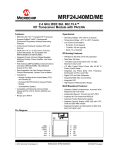


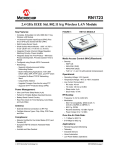

![CS4070 Quick Reference Guide [Italian], P/N MN000763A02IT](http://vs1.manualzilla.com/store/data/006151467_1-08eff54e361d459b79cc675270f2aa3f-150x150.png)
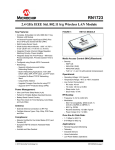
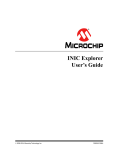
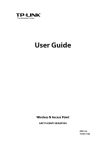
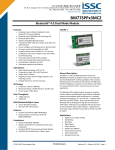
![MC67 with Android OS Regulatory Guide [English] (P/N](http://vs1.manualzilla.com/store/data/006084956_1-8e27f4789c5d6b385775ffdddd01c56d-150x150.png)
![CS4070 Quick Reference Guide [Spanish] P/N MN000763A02ES](http://vs1.manualzilla.com/store/data/006172100_1-c575f13a170a0c72eba289d6b7e2bf2f-150x150.png)
![CS4070 Quick Reference Guide [French] P/N MN000763A02FR](http://vs1.manualzilla.com/store/data/006360309_1-ea04f68b5e72927234ea8d8bec3e4065-150x150.png)
